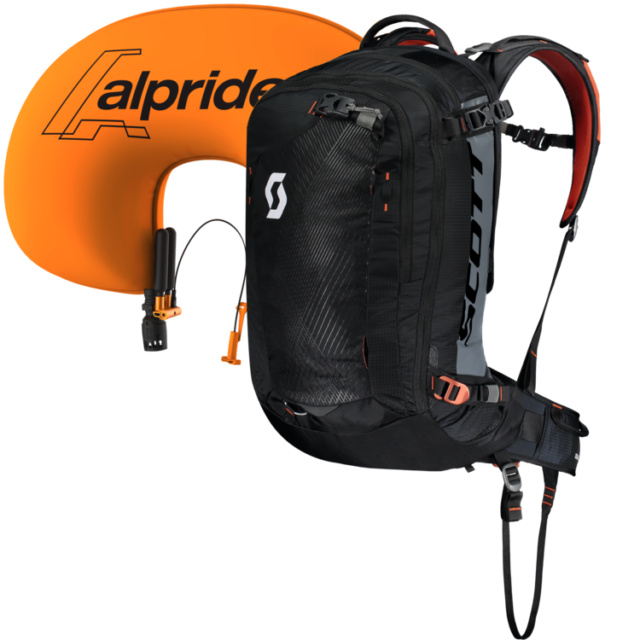
Scott Backcountry Guide AP 30 Kit
Available Sizes: One Size
Stated Weight:
- Pack (without airbag system): 1560 grams
- Alpride 2.0 System: 690 grams
- Cartridges: 440
- Total System: 2690 grams
Blister’s Measured Weight:
- Pack (without airbag system): 1657 grams
- Alpride 2.0 System: 678 grams
- Cartridges: 465 grams
- Total System: 2800 grams
Stated Volume: 30 Liters
Outer Fabrics:
- 420 Denier Nylon Plain Weave (1,500 mm water resistance rating)
- 210 Denier Nylon Double Ripstop (1,000 mm water resistance rating)
Stated Features:
- SCOTT ALPRIDE AIRBAG SYSTEM 2.0 included (cartridges included)
- TÜV-certified
- Diagonal ski carry system
- A-frame ski carry system
- Stow away snowboard fixation
- Separate pocket for safety equipment (shovel, probe)
- Stow away ice axe/pole fixation
- Padded and anatomically shaped hip belt: right side with gear loop, left side with pocket
- Hip belt with safety leg loop
- SOS label with emergency instructions
- Stow away helmet fixation
- Sternum strap with emergency whistle
- Inside map pocket with key holder
MSRP: $850
Test Locations: Cameron Pass & Rocky Mountain National Park, CO; Hokkaido, Japan; Lake Tahoe, CA
Days Tested (Total): ~25
Intro
Each year, manufacturers continue to release new and improved avalanche airbags, all aimed at the goal of decreasing the chance of a deep burial in the event of an avalanche.
Arc’teryx and Black Diamond both now offer electronic fan-based options, and other companies like BCA, Mammut, and Ortovox recently released new versions of their canister-based systems that come in lighter / more compact packages.
Scott, in partnership with Alpride, also recently released a series of bags with the Alpride 2.0 system, which Scott claims is smaller, lighter, and easier to use than the Alpride 1.0 system. Scott also recently revealed a new fan-based system powered by a supercapacitor for 2018-2019, and we are getting time in that pack right now.
Blister reviewer Sam Shaheen and I have both spent a good bit of time using the Scott Backcountry Guide AP 30 kit, which features the new Alpride 2.0 system, and here we will offer our thoughts on the airbag system, and the pack itself.
Here’s what Scott says about the Backcountry Guide AP 30:
“The Backcountry Guide AP 30 is our utilitarian sized ski pack, featuring the Alpride 2.0 airbag system and specific features designed for backcountry adventurers and snow professionals alike. From one-lap dawn patrols to all-day tours and couloir missions, the AP 30 avalanche airbag has everything you need for a fun, safe day in the mountains.”
Fit
The Backcountry Guide AP 30 only comes in one size, and consequently, the fit does not feel quite as dialed as packs like the Mystery Ranch Saddle Peak, which features multiple size options and an adjustable back panel.
That said, the Backcountry Guide AP 30 fits my 5’8” frame pretty comfortably. After adjusting the shoulder straps and hip belt, the pack feels pretty secure, though I do notice it moving around while skiing more than the Saddle Peak (which is one of the most stable ski packs I’ve used). The Saddle peak is also considerably smaller and lower profile, which likely contributes to this.
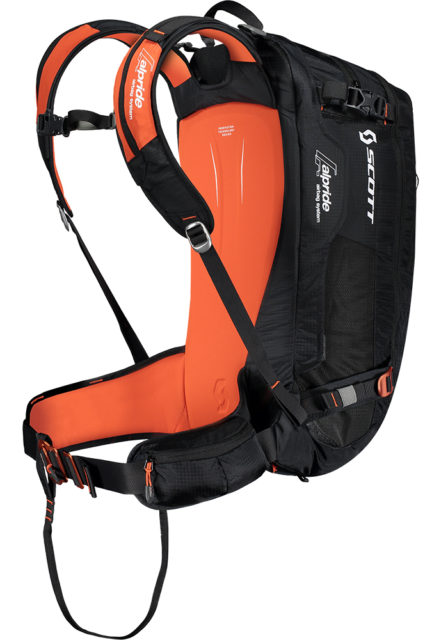
Sam, at 5’10” and 140 lbs, has found the Backcountry Guide AP 30 to fit well — better than the Mammut Pro Protection. The Backcountry Guide AP 30 has a traditional shoulder strap setup, while the Pro Protection houses a substantial part of the airbag in the shoulder straps which can make it tough to get the fit dialed. At 5’10”, the Backcountry Guide AP 30 fits him well, but he wouldn’t recommend it to people a lot smaller than him (it still fits me well at 5’8”).
The Backcountry Guide AP 30 can be adjusted via the waist belt, chest strap, and shoulder straps. The waist belt uses metal buckles similar to those on Mammut’s airbag packs. With some practice, I’ve found the buckles to be easy to use, though Sam has said that he’s found the buckles on the Scott bag to be more difficult to use than the Mammut buckles, and considerably more difficult than the class-leading Arva hip belt buckles. The Backcountry Guide AP 30’s chest strap has an elastic section that makes for a comfortable fit, though I’ve found it difficult to cinch it down as tight as I would like.
Volume
Scott says the Backcountry Guide AP 30 has a volume of 30 liters, and that the Alpride 2.0 system takes up only 1.7 liters of that volume. The Alpride system is stowed around the upper and outer edges of the pack, and I have really come to like this configuration as it leaves much of the main compartment open for storage.
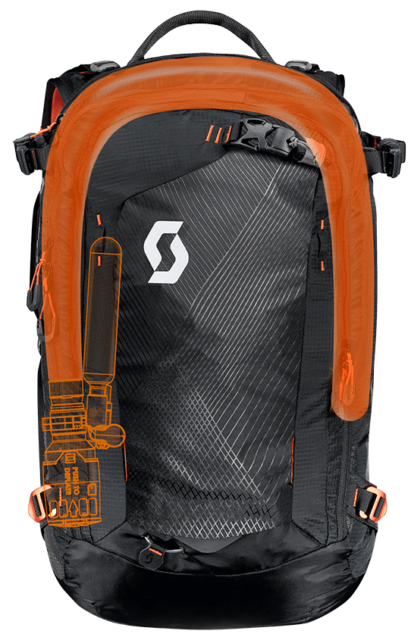
The Backcountry Guide AP 30 is fairly slim (i.e. it doesn’t stick out very far off my back), which I prefer in ski packs. Many airbag packs have pretty large profiles, so considering how much volume the Backcountry Guide AP 30 has, it’s profile is very modest (it’s slimmer than the Arva Reactor 32 and Mammut Pro Protection). I have been able to store everything I need for a full day of touring in the Backcountry Guide AP 30, and it seems like the stated volume is pretty accurate.
Pockets
The Backcountry Guide AP 30 features one large main compartment (where the Alpride 2.0 system is housed), a separate outer pocket for avalanche equipment with a small zippered pocket inside, an upper goggle pocket lined with super soft fleece, and one small pocket on the left hip belt (the other side has a gear loop).
Between all these pockets, I haven’t felt the need for more organization options with the Backcountry Guide AP 30. It has plenty of areas to stash small items, and the main compartment is nice and open.
The main compartment’s zipper runs nearly all the way to the bottom of the pack, allowing it to be opened wide and packed easily. All the pocket zippers are reverse coil, very easy to zip, and feature big plastic zipper pulls.
One feature that Sam and I found ourselves missing was a back panel access zipper, which the Mammut Pro Protection and Ultralight do feature.
Other Features
Scott calls the Backcountry Guide AP 30 “utilitarian,” and I think that’s a good way to describe it. Though the Alpride 2.0 system focuses on low weight, the Backcountry Guide AP 30 pack itself still has plenty of the features I look for in a ski pack.
The front of the pack has an elastic helmet carry sleeve that folds neatly and easily under a flap when not in use, and the hooks it uses to attach to the pack are very easy to use, even with gloves. The helmet carry system can be folded up so the helmet sits on the face of the pack, or down so that it is stowed on the bottom of the pack. I like having both options in case I want easy access to the front panel of the pack.
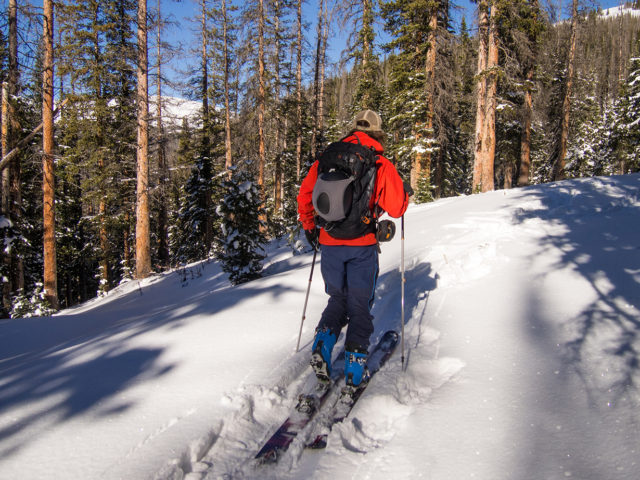
The Backcountry Guide AP 30 also has ice tool attachment bungees, a vertical snowboard carry strap, and wire diagonal ski carry loop. All of these features are stowable in discreet pockets on the pack.
The upper side compression straps use buckles with larger tabs so they’re easier to use with gloves, and the lower compression straps use metal hooks and reinforced straps to deal with ski edges. The upper strap for diagonal ski carrying also uses the glove-friendly buckles, and all the straps have elastic or velcro to roll up the extra webbing.
Alpride 2.0 System
Though the pack itself is important, if you’re considering buying an avalanche airbag, the actual airbag system is likely the priority. (It’s also worth noting that the Alpride 2.0 system is completely removable from the Backcountry Guide AP 30 pack, and can be swapped to other Alpride 2.0 compatible packs).
Though neither Sam nor I have had to deploy the Alpride 2.0 system in an actual avalanche (thankfully), we can comment on some of its notable features.
Weight
With a stated weight of 690 grams (ours measured in at 678 grams), the Alpride 2.0 system has the exact same stated weight of the Ortovox Avabag system. With the 2 canisters required for use, the Alpride 2.0 system comes in at 1143 grams.
Below are a few stated weights of some other notable airbag systems. These stated weights include full canisters / batteries, and are in grams.
1000 Ortovox Avabag
1010 Mammut Removable Airbag 3.0 (with carbon cartridge)
1130 Scott Alpride 2.0
1240 Scott Alpride 1.0
1280 Scott Alpride E1
2000 Black Diamond Jetforce
So, the Alpride 2.0 system is coming in at a pretty respectable weight compared to the competition, though it isn’t the lightest option out there.
Cartridges
Both the Alpride 1.0 and 2.0 systems utilize a 2-cartridge system — one CO2 and one Argon. Together, the canisters we tested came in at 465 grams.
Alpride says that this dual-cartridge system is very similar to those used on inflatable life vests for boating.
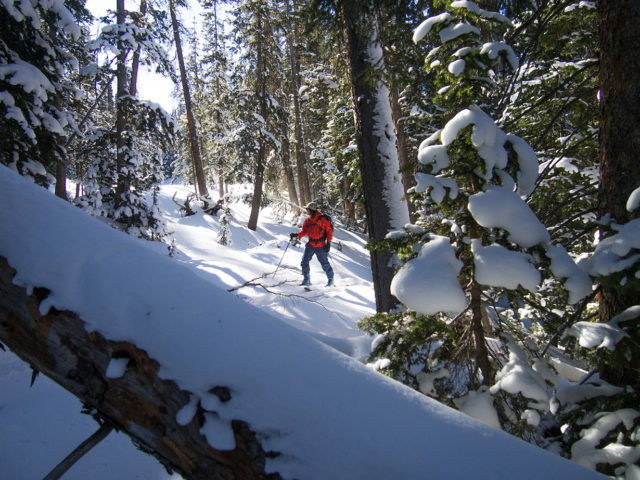
One important difference between the Alpride system and other canister systems is that the Alpride canisters are not refillable / reusable. After inflation, you must dispose of the canisters and purchase new ones.
Scott has a list of European dealers on the Backcountry Guide AP 30 product page, and they informed us that people can order cartridges through any authorized Scott dealer in the U.S. or Canada.
Travel
Here’s what Scott says about traveling with the Alpride 2.0 system:
“The IATA (International Air Transport Association) declares safe travel as Alpride cartridges are just like the ones found in the inflatable life jackets on airplanes. The user is allowed to travel with 2 sets of cartridges for one pack. In 2014, the IATA has changed the existing rules, creating a special category for safety inflatable devices. The Alpride device perfectly adheres to these new changes.”
With that said, it’s always wise to check the policies of the airline you’re flying whenever flying with an airbag just to ensure easy travel.
Activation / Trigger
The Alpride 2.0 system features a new trigger, and it can be adjusted up and down the shoulder strap on a few webbing loops so that different sized people can keep it at the optimal height for easy use. You can also route the trigger / wire to either shoulder strap.
To me, the trigger feels easy to grab, and it can be zipped away in the shoulder strap sleeve when not in use. Since both shoulder straps feature sleeves for the trigger, the one you don’t use for the trigger itself can be used to secure a hydration tube.
Packed Size
The Alpride 2.0 system is said to only take up 1.7 liters of volume when packed down, and as I noted earlier, the system wraps in a “U” shape around the main compartment. I like this setup, and it keeps much of the main compartment open for storage of other gear.
Ski Carry
One of the important differences between the Backcountry Guide AP 30 and other airbag packs is the ability to carry skis A-frame style while still being able to deploy the airbag. This is very significant if you prefer to carry your skis A-frame style and occasionally do so in avalanche terrain.
The diagonal ski carry on the Backcountry Guide AP 30 also works very well, and the wire loop can be stowed away when not in use.
In Use
Despite not having multiple size options and only a plastic frame sheet and some foam padding, I’ve been pleasantly surprised by how well the Backcountry Guide AP 30 carries weight. It doesn’t distribute heavy loads as well as the beefier Mystery Ranch Saddle Peak, but I have been comfortable in the pack with a full day’s worth of touring gear during long day-tours.
When it comes time to actually ski, the Backcountry Guide AP 30 feels pretty stable, and this is where the lack of a metal frame becomes a positive — the back panel conforms pretty well to my back, and I don’t notice the pack shifting around all that much. It’s not the most stable / secure fit I’ve felt in a pack (that award goes to the Saddle Peak), but for an airbag pack, I’ve been happy with how the Backcountry Guide AP 30 feels while skiing.

Durability
After about 25 days of use between Sam and I, we have no durability issues to report. We’ll update this review should anything arise.
Bottom Line
The Scott Backcountry Guide AP 30 Kit combines a fairly light and compact airbag system with a very useful pack design, making it a great all-around ski pack. The Alpride 2.0 system’s shape is conducive to easy packing, it allows for full functionality while using the A-frame ski carry, and the replaceable / disposable cartridge system requires very little maintenance. The pack itself has pretty much all the features one could want from a ski pack, and still maintains a fairly sleek profile and decent stability while skiing. Overall, the Backcountry Guide AP 30 Kit has performed very well in a variety of skiing situations, and is definitely worth a look if you’re in the market for an airbag pack.

Hi !
You write that the AP Gudie 30 has a padded fleece pocket for googles. I know last years Air AP32 had one but it is not stated anywhere on the scott material page and in the pic comared to last years AP32 it does not seem to have a zipper?
I am looking into getting this one since last years super nice red AP32 is out of stock everywhere and need the fleece pocekt to not be omitted, coz the E1 30 seems to have it. Hope it did not fall victim to marketing decisions….
I just double-checked with Scott, and the current AP 30 does indeed have the fleece-lined goggle pocket (that pack is not being changed from last year’s version). The pocket is not padded, but it does have a soft fleece lining that should not scratch goggle / sunglasses lenses.
Have you gotten time on the fan-based system? Any views on that one?
We have been using the E1 bag, and will be posting a review in the coming weeks.
Looking forward it. Any short comment ie. would you recommend buying it or are there some big concerns?
No major concerns so far. As with any new system, long-term durability and reliability is a big question, but we haven’t had any issues yet. The short story so far is that the actual backpack of the E1 is pretty minimal and seems better suited to light-and-fast use, whereas the Backcountry Guide AP 30 is a bit more versatile and has more features for people who aren’t as concerned with weight.
Ok, thanks – should work as a great day touring pack and easy to travel with it (travelling by air a lot).